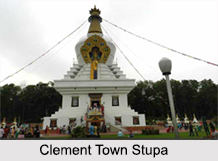 Clement Town Stupa is situated in Clement town of Dehradun district in Uttarakhand. This Tibetan settlement is the largest stupa of the world. It is a part of the Mindroling Monastrey of Tibet. Clement Town Stupa was inaugurated in 28th October in the year 2002. Clement town stupa is popularly known as the Great Stupa, which was constructed for world peace.
Clement Town Stupa is situated in Clement town of Dehradun district in Uttarakhand. This Tibetan settlement is the largest stupa of the world. It is a part of the Mindroling Monastrey of Tibet. Clement Town Stupa was inaugurated in 28th October in the year 2002. Clement town stupa is popularly known as the Great Stupa, which was constructed for world peace.
Structure of Clement Town Stupa
The stupa is 185 ft in length and 100 sq ft in width with a two-acre lush green garden around it. The architecture of the stupa is a magnificent example of Buddhist art. Shrine rooms with elaborate murals are executed in the finest tradition of Tibetan Buddhist art. There is a 103 feet high statue of Buddha which is dedicated to Dalai Lama.
Visiting Information to Clement Town Stupa
Dehradun airport and Dehradun railway station are the nearest to the spot. Clement Town Stupa can also be reached by road via National Highway 72A.
This article is a stub. You can enrich by adding more information to it. Send your Write Up to content@indianetzone.com



















